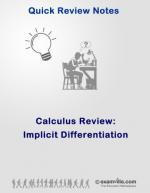|
This section contains 455 words (approx. 2 pages at 300 words per page) |

|
Implicit differentiation is a technique used in calculus to compute the derivative of functions even when an explicit formula for the function is unknown. This technique is a consequence of a general theorem, called the implicit function theorem, which enables mathematicians to produce a limitless supply of smooth curves and surfaces.
A variable y is said to be an explicit function of another variable, x, if there is an equation y = f(x) relating y to x. Here f represents a function, in other words a rule that assigns to each value of x one and only one value of y. But the equations of many classical curves, such as the circle x2 + y2 = 1, are not written in the standard y = f(x) format. Instead, x and y are mutually dependent, and so it is not immediately clear whether y can actually be considered to be...
|
This section contains 455 words (approx. 2 pages at 300 words per page) |

|


